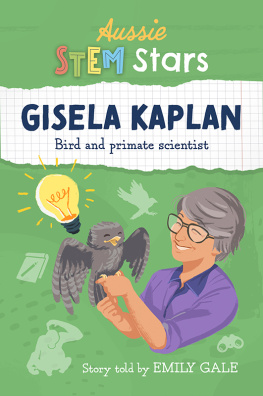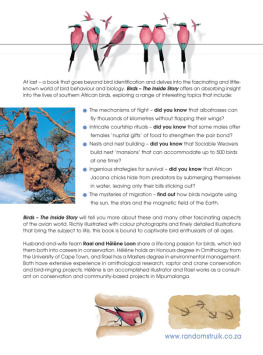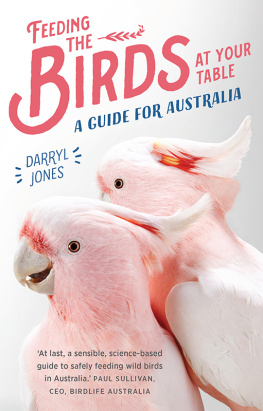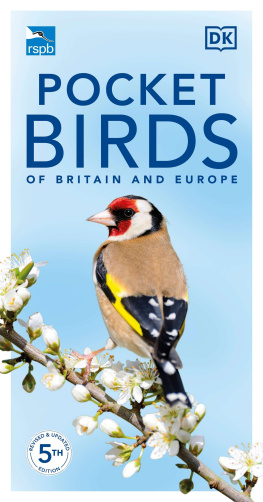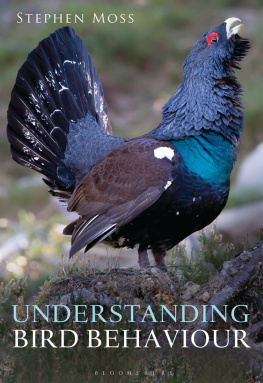Gisela Kaplan - Bird Minds: Cognition and Behaviour of Australian Native Birds
Here you can read online Gisela Kaplan - Bird Minds: Cognition and Behaviour of Australian Native Birds full text of the book (entire story) in english for free. Download pdf and epub, get meaning, cover and reviews about this ebook. year: 2015, publisher: CSIRO Publishing, genre: Romance novel. Description of the work, (preface) as well as reviews are available. Best literature library LitArk.com created for fans of good reading and offers a wide selection of genres:
Romance novel
Science fiction
Adventure
Detective
Science
History
Home and family
Prose
Art
Politics
Computer
Non-fiction
Religion
Business
Children
Humor
Choose a favorite category and find really read worthwhile books. Enjoy immersion in the world of imagination, feel the emotions of the characters or learn something new for yourself, make an fascinating discovery.

- Book:Bird Minds: Cognition and Behaviour of Australian Native Birds
- Author:
- Publisher:CSIRO Publishing
- Genre:
- Year:2015
- Rating:4 / 5
- Favourites:Add to favourites
- Your mark:
- 80
- 1
- 2
- 3
- 4
- 5
Bird Minds: Cognition and Behaviour of Australian Native Birds: summary, description and annotation
We offer to read an annotation, description, summary or preface (depends on what the author of the book "Bird Minds: Cognition and Behaviour of Australian Native Birds" wrote himself). If you haven't found the necessary information about the book — write in the comments, we will try to find it.
Gisela Kaplan: author's other books
Who wrote Bird Minds: Cognition and Behaviour of Australian Native Birds? Find out the surname, the name of the author of the book and a list of all author's works by series.
Bird Minds: Cognition and Behaviour of Australian Native Birds — read online for free the complete book (whole text) full work
Below is the text of the book, divided by pages. System saving the place of the last page read, allows you to conveniently read the book "Bird Minds: Cognition and Behaviour of Australian Native Birds" online for free, without having to search again every time where you left off. Put a bookmark, and you can go to the page where you finished reading at any time.
Font size:
Interval:
Bookmark:
BIRD MINDS
Cognition and Behaviour of Australian Native Birds

Gisela Kaplan

Gisela Kaplan 2015
All rights reserved. Except under the conditions described in the Australian Copyright Act 1968 and subsequent amendments, no part of this publication may be reproduced, stored in a retrieval system or transmitted in any form or by any means, electronic, mechanical, photocopying, recording, duplicating or otherwise, without the prior permission of the copyright owner. Contact CSIRO Publishing for all permission requests.
National Library of Australia Cataloguing-in-Publication entry
Kaplan, Gisela, author.
Bird minds: cognition and behaviour of Australian native birds/Gisela Kaplan.
9781486300181 (paperback)
9781486300198 (epdf)
9781486300204 (epub)
Includes bibliographical references and index.
Birds Australia Behavior.
Birds Psychology.
Animal intelligence.
598.07234994
Published by
CSIRO Publishing
Locked Bag 10
Clayton South VIC 3169
Australia
Telephone: +61 3 9545 8400
Email: publishing.sales@csiro.au
Website: www.publish.csiro.au
Front cover: Major Mitchell Cockatoos (photo: Keith Lightbody)
Back cover: author photo by Lesley Rogers
Set in Adobe Garamond Pro 10.5/13.5
Edited by Peter Storer Editorial Services
Cover design by Alicia Freile, Tango Media
Typeset by Desktop Concepts Pty Ltd, Melbourne
Printed in China by 1010 Printing International Ltd
CSIRO Publishing publishes and distributes scientific, technical and health science books, magazines and journals from Australia to a worldwide audience and conducts these activities autonomously from the research activities of the Commonwealth Scientific and Industrial Research Organisation (CSIRO). The views expressed in this publication are those of the author(s) and do not necessarily represent those of, and should not be attributed to, the publisher or CSIRO. The copyright owner shall not be liable for technical or other errors or omissions contained herein. The reader/user accepts all risks and responsibility for losses, damages, costs and other consequences resulting directly or indirectly from using this information.
Original print edition:
The paper this book is printed on is in accordance with the
rules of the Forest Stewardship Council. The FSC
promotes environmentally responsible, socially beneficial
and economically viable management of the worlds forests.
Contents
Preface
The idea for this book had its beginning some 15 years ago when our galah, at the age of 75, learned new words. If ever there was evidence of a plastic brain, he showed it convincingly but there was relatively little to which it could be related in Australian species at the time. There were few papers that discussed the cognitive ability of Australian cockatoos, or other birds for that matter. Of course, there had been important ideas and observations about the cognitive and emotional dimensions in a long and weighty history of avian behaviour as the writings by Charles Darwin (1890, 1965, 1981), then Niko Tinbergen (1953), W. H. Thorpe (1956), Konrad Lorenz (1966) and others attest. From the late 1970s onwards, it was once again raised as a possibility that some birds and other animals may have plastic brains (Kroodsma and Miller 1996), may have minds of their own and are capable of actions beyond those that are pre-programmed, adaptive or merely copied from others (Griffin 1984, 1992; Roitblat 1987; Ristau 1991; Rogers 1997; Basil et al. 1996; Balda et al. 1998).
The last decades have been extremely exciting for anyone in animal behaviour working with birds, primates or a range of other species. For a host of reasons, the last decades have seen many breathtaking discoveries that have changed forever the landscape of our knowledge about animal cognition and related fields. It is now hard to imagine how people thought before the 1980s, so vast have the changes been, be this in discoveries in field research or in the identification of new methods or theories resulting in robust data and clear evidence of complex cognition in birds.
Hence, my search for evidence of problem solving, tool use and other indices of intelligence in Australian birds became a road of discovery, spreading the search for the printed record to well over 100 years, strewn with new and surprising insights and findings. This book is timely because there are new theories and novel experimental techniques and methods for data collection available that enable us to probe into cognitive processes of birds in previously unimaginable ways.
Vertebrates are able to perform cognitively complex tasks, solve complex problems and generally show behaviour suggesting much more awareness than had once been assumed. Indeed, it is now known that some birds have many of the attributes once thought to be specific to humans and great apes.
Who would have thought that the humble chicken understood object permanence, was capable of distinguishing biological motion, could perceive illusions, could perform basic arithmetic and geometry and even had referential signals for various alarm calls, or that pigeons understand principles of same/different and were capable of quite abstract generalisations as in identifying concepts such as forest versus individual trees or shrubs? The problem of having been captive long term somehow seemed to suggest, however, that chickens and pigeons had been selected for these skills because of their long exposure to humans (i.e. their abilities were artefacts that might not pertain to birds in the wild). So the new wave of interest in cognitive ornithology was to find evidence of intelligence in wild-caught birds, either by capturing them and seeing how they behave under experimental conditions in laboratories, or by somehow exposing their cognitive capacity in the wild. Ravens, crows and a few parrots have been riding on a crest of fame fanned by journalists worldwide about their amazing and newly discovered abilities of problem solving, tool using, episodic memory, planning and many other attributes.
There has been a different emphasis in Australia and one that is more than of marginal importance because it deeply altered the way in which avian evolution could be perceived. Eleanor Russell (1989) implored us to think from a Gondwanan perspective. The question is why one should, and the inspiring work in taxonomy gave the answer: birds evolved in Australia. In the last 1015 years, large-scale DNA-sequence analyses have revolutionised our understanding of the evolution of the worlds avifauna, as Christidis and Norman (2010) explained recently. It has led to an enormously active and exciting period in Australian taxonomy, continuing to correct misconceptions and wrong attributions. The evidence now makes it conclusive that there is a very special relationship between Australia and birds.
I was recently asked whether there is anything special about Australian birds. This was one of those heart-stopping moments when one feels one ought to be able to reply with a few well-expressed sentences and yet make the enormity of the implied misconception clear. But to answer it, I found it necessary to write a whole book in reply.
It will take a while for other countries and for Australians themselves to come to terms with the findings. The misconceptions have been substantial, both in the northern hemisphere and in Australia. One of them arose within the recent social history of Australia. Settlers arriving here in the 19th century, often from the British Isles and continental Europe, were confronted by a land so very strange that the simplest emotional response (of course not the only one) to the strange plants was to call them scrub (good for burning) and the animals inferior (good at best for shooting and eating) and, if possible, replace them with species known and familiar to the new settlers. These same well-meaning settlers produced the largest known transfer of invasive species and foisted on this continent the most large-scale and highly destructive onslaught known on the planet, both in flora or fauna. History must excuse their deeds for they believed indeed that the continent was a barren world where only the lowliest of plants and animals had persisted.
Next pageFont size:
Interval:
Bookmark:
Similar books «Bird Minds: Cognition and Behaviour of Australian Native Birds»
Look at similar books to Bird Minds: Cognition and Behaviour of Australian Native Birds. We have selected literature similar in name and meaning in the hope of providing readers with more options to find new, interesting, not yet read works.
Discussion, reviews of the book Bird Minds: Cognition and Behaviour of Australian Native Birds and just readers' own opinions. Leave your comments, write what you think about the work, its meaning or the main characters. Specify what exactly you liked and what you didn't like, and why you think so.

